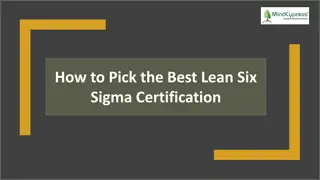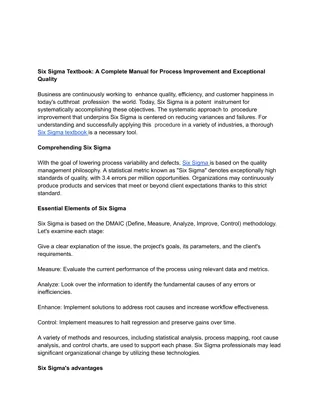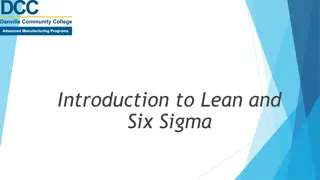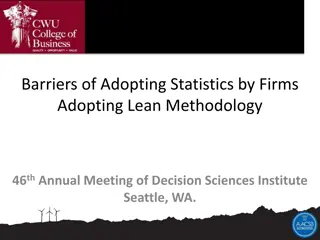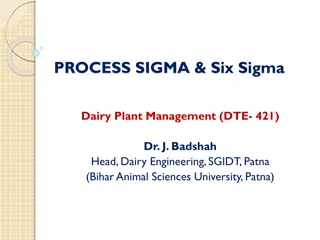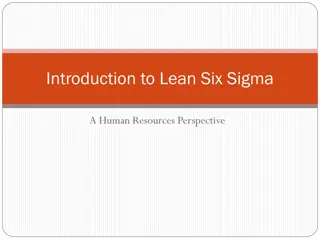
Implementing Six Sigma: A Strategic Approach for Quality Enhancement
Unlock the power of Six Sigma to elevate business performance with precision and efficiency. Learn about Six Sigma as a data-driven improvement technique, blending management, financial, and methodological elements to drive process and product enhancements. Discover how defining, measuring, analyzing, improving, and controlling processes can lead to superior quality outputs, all while striving for just 3.4 defects per million opportunities. Embrace the Six Sigma philosophy to navigate the ever-changing business landscape effectively.
Download Presentation

Please find below an Image/Link to download the presentation.
The content on the website is provided AS IS for your information and personal use only. It may not be sold, licensed, or shared on other websites without obtaining consent from the author. If you encounter any issues during the download, it is possible that the publisher has removed the file from their server.
You are allowed to download the files provided on this website for personal or commercial use, subject to the condition that they are used lawfully. All files are the property of their respective owners.
The content on the website is provided AS IS for your information and personal use only. It may not be sold, licensed, or shared on other websites without obtaining consent from the author.
E N D
Presentation Transcript
University of Patras Department of Business Administration of Food and Agricultural Enterprises Six Sigma in the services sector Evangelos L. Psomas
To keep on providing quality products and services To meticulously deploy the scarce funds available To deliver multidirectional benefits in a relatively shorter duration of time To cope with the turbulent business environmental changes A breakthrough strategy 6 sigma
A science A data-driven improvement technique An organizational phenomenon A total quality improvement philosophy A process improvement framework A management philosophy A problem-solving methodology
Six sigma Blends management, financial and methodological elements To make improvements to processes and products concurrently
Six sigma Uses both statistical and non-statistical tools/techniques To eliminate process variation To improve process performance and capability
d > 6s USL LSL Sig sigma definition m 3s 6s d > 6s LSL USL m 3s 6s m = the mean value of the quality characteristic, s = standard deviation of a sample USL, LSL = Upper and Lower Specification Limit
The term Six Sigma is defined as having less than 3.4 defects per million opportunities or a success rate of 99.99966%. The higher the sigma level, the less likely it is that a process will create defective parts.
Six Sigma Quality Six-Sigma Problem Solving Approach 1. Define 2. Measure 3. Analyze 4. Improve 5. Control 8
Tools for Six-Sigma and Quality Improvement Elementary statistics Advanced statistics Product design and reliability Process control Process improvement Implementation and teamwork
Applied to all types of organizations Manufacturing companies Service companies Public organizations Private organizations Large sized enterprises Small and medium sized enterprises
Applied to functional areas Engineering Administrative support Educational institutions Call center services Marketing services Healthcare services Banking services Retail companies Supply chain operations (including food) Research libraries
Difficulties of Six Sigma The selection of the process parameters to be statistically analyzed Management of the Six Sigma projects (e.g. selection, extent and time required) Implementation cost Lack of a sustainable, structured and no paper- loaded approach Lack of strategic planning in line with 6 principles Inadequate training know-how, skills, employees
Benefits from Six Sigma Customer satisfaction Improved company position in the market Process management improvement Improvement of internal operations Employees benefits Improvement of financial performance

